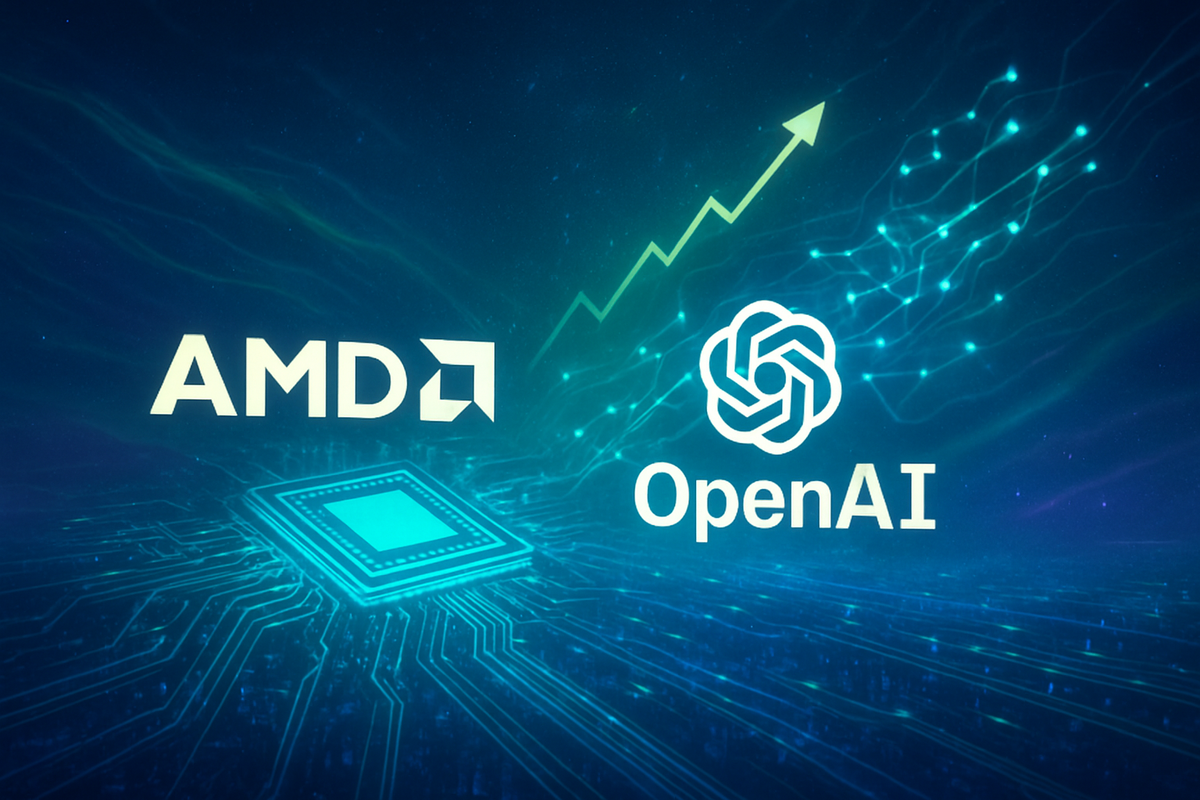
In a significant development reverberating through the semiconductor industry, Mizuho Securities has substantially increased its price target for Advanced Micro Devices (NASDAQ: AMD) to $275 from $205, reaffirming its "Outperform" rating. This optimistic revision, announced on October 13, 2025, comes on the heels of AMD's groundbreaking multi-year, multi-generation strategic partnership with OpenAI, unveiled just a week prior on October 6, 2025. The collaboration, which commits OpenAI to deploying 6 gigawatts (GW) of AMD Instinct GPUs for its next-generation AI infrastructure, is poised to reshape the competitive landscape of the burgeoning AI chip market and solidify AMD's position as a formidable player.
This landmark deal not only provides substantial institutional validation for AMD's aggressive AI strategy but also signals a potential paradigm shift in the supply dynamics for high-performance AI accelerators. With the initial phase of deployment set for the second half of 2026, and projections of tens of billions in revenue for AMD, the market is closely watching how this alliance will impact both companies and the broader technology sector.
A Deep Dive into AMD's Game-Changing OpenAI Alliance
The core of Mizuho's bolstered confidence lies in the comprehensive strategic partnership between Advanced Micro Devices (NASDAQ: AMD) and OpenAI. Announced on October 6, 2025, this agreement is far more than a simple supply contract; it represents a multi-year, multi-generation commitment that will see OpenAI integrate 6 gigawatts (GW) of AMD Instinct GPUs into its expansive AI infrastructure. The initial deployment, slated for the second half of 2026, will involve 1 GW of AMD Instinct MI450 GPUs and associated rack-scale systems, marking a critical step in powering OpenAI's future AI models.
A unique and particularly noteworthy aspect of this collaboration is the innovative equity arrangement. AMD has issued OpenAI a performance-based warrant for up to 160 million shares of AMD common stock, exercisable at a nominal price. This structure allows OpenAI to potentially acquire approximately 10% of AMD's outstanding shares, with vesting tied to a series of operational and financial milestones. These include the successful 1 GW deployment, AMD achieving specific share price targets, and OpenAI reaching its own technical and commercial benchmarks. This equity component aligns the long-term interests of both companies, fostering a deeper partnership beyond a mere customer-supplier relationship.
AMD anticipates that this monumental deal will generate "tens of billions of dollars in revenue," with some industry analysts projecting figures as high as $60 billion to $100 billion through 2030. AMD's Chief Financial Officer, Jean Hu, has underscored the expected "highly accretive" nature of the agreement to AMD's non-GAAP earnings-per-share, emphasizing its potential to significantly enhance shareholder value. This financial outlook, coupled with the strategic importance of supplying a leading AI innovator like OpenAI, has been a primary driver of investor enthusiasm.
The market's reaction has been swift and overwhelmingly positive. Following the deal's announcement on October 6, 2025, AMD stock surged by an impressive 24% on October 7. The subsequent Mizuho price target hike on October 13 further propelled shares, which rose over 2% to $219.57, contributing to a remarkable year-to-date gain of nearly 84% for AMD's stock. This robust market response reflects a widespread belief that the OpenAI partnership serves as a powerful institutional validation of AMD's long-term AI strategy and its competitive prowess in the high-stakes AI accelerator market.
Reshaping the Chip Landscape: Winners, Losers, and Strategic Shifts
The monumental partnership between Advanced Micro Devices (NASDAQ: AMD) and OpenAI is set to significantly recalibrate the competitive dynamics within the high-stakes AI chip market, creating clear winners and intensifying pressure on established players. AMD, without a doubt, emerges as a primary beneficiary. The multi-gigawatt commitment from OpenAI, coupled with the equity arrangement, provides a powerful validation of AMD's Instinct GPU roadmap and its open-source ROCm software stack. This deal not only guarantees substantial, long-term revenue streams—projected to be tens of billions of dollars—but also elevates AMD's credibility as a viable, large-scale alternative to the incumbent leader in AI accelerators. Mizuho's increased price target reflects this newfound market confidence, projecting substantial incremental revenue and a doubling of AMD's EPS by 2027-2028.
On the other side of the spectrum, Nvidia (NASDAQ: NVDA), which has long held a near-monopoly on data center GPU shipments, faces its most significant competitive challenge yet. While OpenAI also has a substantial, even larger, deal with Nvidia for its Vera Rubin platform, the AMD partnership signals a strategic diversification by OpenAI to reduce its reliance on a single vendor. This move is expected to intensify competition, potentially pressing Nvidia's pricing and profit margins over time. The deep access OpenAI gains to AMD's open-source ROCm stack is particularly noteworthy, as it offers greater flexibility compared to Nvidia's proprietary CUDA ecosystem, which has historically created vendor lock-in. This could force Nvidia to re-evaluate its software strategy and potentially open up its ecosystem further.
Intel (NASDAQ: INTC), a perennial competitor in the broader semiconductor space, also finds itself under increased pressure. Having been slower to pivot to high-performance AI hardware, Intel's AI chip strategy, including its Gaudi accelerators, will need to accelerate innovation to compete effectively. In a proactive response, Intel has reportedly deepened its ties with Nvidia, announcing a strategic collaboration in September to develop AI infrastructure and personal computing products. This alliance aims to leverage Nvidia's AI software expertise and Intel's hardware footprint, suggesting a defensive yet strategic maneuver to retain and recapture market share in the rapidly evolving AI landscape.
Beyond the direct competitors, the deal creates ripple effects across the broader semiconductor supply chain. Suppliers of High Bandwidth Memory (HBM) and advanced chip packaging technologies, such as Samsung (KRX: 005930) – a key HBM4 supplier for the MI450 chips – and companies involved with UALink technology like Astera Labs (NASDAQ: ALAB), are poised to benefit from the increased demand for advanced components. Furthermore, the partnership highlights a growing trend towards custom silicon, with OpenAI itself collaborating with Broadcom (NASDAQ: AVGO) on its own custom chips, indicating that specialized or cost-effective solutions from smaller AI chip companies could also find new opportunities.
Cloud providers, including Microsoft (NASDAQ: MSFT) (a major investor in OpenAI) and Oracle (NYSE: ORCL), are also strategically impacted. The AMD-OpenAI deal encourages these providers to diversify their AI hardware offerings beyond Nvidia, providing more choices to their customers and reducing their own dependency on a single GPU vendor. The massive 6-gigawatt deployment commitment also implies multi-billion dollar investments in data center infrastructure, benefiting companies involved in construction, power, and cooling solutions. Ultimately, increased competition and an injection of cash into AMD's AI efforts could lead to improved availability and potentially more competitive pricing for AI GPUs across the cloud market.
Broadening Horizons: AI's March and Market Transformation
The AMD-OpenAI partnership is not merely a corporate deal; it's a potent indicator of the accelerating pace of innovation and strategic recalibration within the broader artificial intelligence and semiconductor industries. This event perfectly encapsulates several overarching trends that are defining the current technological era. Firstly, it underscores the insatiable demand for AI compute power, with the AI chip market projected to reach nearly $158 billion by 2029. The 6-gigawatt commitment alone for OpenAI's infrastructure highlights the staggering energy and processing requirements needed to train and deploy next-generation AI models.
This alliance also signifies a crucial shift towards diversification in the AI supply chain. For years, Nvidia's CUDA ecosystem has been the de facto standard, creating a powerful moat. OpenAI's decision to partner with AMD, and to gain deep access to its open-source ROCm stack, reflects a strategic imperative among large AI developers to reduce vendor lock-in and foster a more competitive, flexible hardware environment. This move could inspire other major AI players to explore alternative hardware solutions, thereby fostering a healthier, more competitive ecosystem that benefits from diverse innovations.
The deal further emphasizes the growing importance of software-hardware co-design and open-source platforms. OpenAI's engagement with AMD's ROCm is a testament to the fact that raw hardware power alone is insufficient; a robust, developer-friendly, and open software stack is critical for unlocking the full potential of AI accelerators. This trend is likely to push all chip manufacturers to invest more heavily in their software ecosystems, potentially leading to more open standards and greater interoperability across different hardware platforms.
From a macroeconomic perspective, the scale of this partnership—and the tens of billions of dollars in revenue it promises for AMD—has significant ripple effects. It injects substantial capital into the semiconductor industry, stimulating further research and development. The massive infrastructure build-out required for 6 GW of AI compute will benefit numerous ancillary industries, from power generation and cooling solutions to data center construction and real estate. This surge in demand and investment is already contributing to global market rallies in chipmaking nations, indicating a broader economic impact driven by the AI revolution.
Regulatory implications, while not immediately apparent from the deal itself, loom large over the rapidly consolidating and expanding AI chip market. The sheer scale of investments and partnerships, such as this one and Nvidia's ongoing engagements, could attract increased scrutiny from antitrust regulators concerned about market concentration and fair competition. Furthermore, the astronomical energy demands of AI data centers, exemplified by the 6 GW commitment (equivalent to the energy needs of millions of households), will inevitably lead to greater focus on environmental, social, and governance (ESG) factors, compelling companies to prioritize energy efficiency, renewable energy sources, and transparent reporting of their environmental footprint. Geopolitical considerations, particularly US export controls on advanced semiconductors to China, continue to shape supply chains and market access, adding another layer of complexity for global chip manufacturers.
The Road Ahead: Navigating AI's Evolving Landscape
The AMD-OpenAI partnership sets the stage for a dynamic period of evolution in the AI chip market, presenting both short-term and long-term possibilities. In the immediate future, AMD's credibility as a major AI compute provider is significantly boosted, attracting further interest from other hyperscalers and AI firms seeking diversified solutions. The deep technical collaboration with OpenAI, focusing on optimizing AMD's product roadmaps and fine-tuning systems for advanced AI workloads, promises accelerated innovation in both hardware (like the MI450 and future generations) and software. For OpenAI, this deal is a critical step in securing a robust and diversified compute supply chain, mitigating risks associated with reliance on a single vendor.
Looking ahead, the long-term implications point towards a gradual erosion of Nvidia's (NASDAQ: NVDA) near-monopoly in AI accelerators, fostering a more competitive, multi-vendor ecosystem. AMD is poised to emerge not just as a challenger, but as a strategic partner capable of co-developing the future of AI infrastructure. This elevated status could lead to more significant partnerships and broader adoption of AMD's Instinct GPUs and ROCm software. The increased focus on inference, driven by the need to scale AI applications to vast user bases, positions AMD's cost-effective MI series chips as a strong contender in this growing segment.
To fully capitalize on this opportunity, AMD will need to execute several strategic pivots. Scaling production to meet the 6-gigawatt commitment, alongside demand from other customers, will be paramount. Continuous, heavy investment in its ROCm software stack to match or surpass Nvidia's CUDA ecosystem in robustness and developer appeal is crucial. Deepening customer-specific engagements, moving beyond transactional sales to true co-development, will solidify its position. Furthermore, a relentless focus on power efficiency and demonstrating superior total cost of ownership (TCO) will be key differentiators as AI infrastructure continues its massive expansion.
Market opportunities abound in the explosive growth of AI infrastructure and the industry's desire for supply chain diversification. The increasing adoption of AI across various enterprises, beyond just hyperscalers, also presents a vast market for AMD's solutions. However, challenges remain significant, including Nvidia's entrenched dominance, the capital-intensive nature of infrastructure build-out, the fierce competition for AI talent, and the rapid pace of technological evolution in AI. The massive power consumption of AI data centers also presents an ongoing challenge for sustainability and infrastructure.
Conclusion: A New Era for AI Compute
The AMD-OpenAI deal is a transformative strategic partnership, marking a pivotal moment for both companies and the broader AI industry. It unequivocally solidifies AMD's role as a core compute partner for a leading AI innovator, providing significant revenue and market validation that is expected to drive further adoption of its Instinct GPUs. Crucially, the deal signifies OpenAI's commitment to diversifying its AI compute supply chain, fostering a more resilient and competitive environment. The emphasis on software development and ecosystem building around ROCm is as vital as hardware performance for AMD's sustained success.
Moving forward, the AI chip market is clearly entering a new era characterized by unprecedented demand, intense competition, and a strategic push for diversification. While Nvidia's formidable lead will be challenged, its continuous innovation ensures it remains a powerful force. AMD's partnership with OpenAI strategically positions it to significantly expand its market share and influence, particularly as the industry prioritizes efficiency and cost-effectiveness for AI inference workloads. The emerging trend towards custom AI silicon also suggests a future where hybrid approaches, combining off-the-shelf GPUs with specialized ASICs, become increasingly common.
For investors, the coming months will be critical. Watch closely for AMD's execution in scaling production of its MI450 and subsequent generations, and monitor the vesting of OpenAI's stock warrants as a key indicator of the partnership's success. The growth of the ROCm ecosystem and new customer wins for AMD beyond OpenAI will signal its expanding market penetration. Financial performance of AMD's data center segment will be paramount, alongside Nvidia's strategic responses to this intensified competition. Finally, advancements in power efficiency across all AI chips will be a crucial metric to track, given the enormous energy demands of the AI revolution.
This content is intended for informational purposes only and is not financial advice





